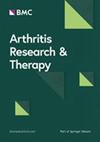确定抗mda5抗体患者预后不良的两条途径:来自预后因素和细胞因子分析的见解
IF 4.6
2区 医学
Q1 Medicine
引用次数: 0
摘要
通过抗黑色素瘤分化相关蛋白5抗体(抗mda5 Ab)患者的预后因素,确定细胞因子异常与死亡率之间的联系途径。本研究纳入了血清可用的抗mda5抗体患者。血清细胞因子水平测定采用多重头试验。采用Cox回归和log-rank检验确定预后因素。采用主成分分析(PCA)、因子和聚类分析确定预后因素组。细胞因子水平与预后因素(组)之间的关系采用主成分分析、相关分析和通径分析。利用不同组的预后因素建立预后预测模型。本研究纳入35例患者,其中31例患有快速进展性间质性肺病(RP-ILD), 14例死亡。我们发现白细胞(WBC)、γ-谷氨酰转肽酶(γ-GTP)、乳酸脱氢酶(LDH)、c反应蛋白(CRP)、铁蛋白和白细胞介素相关因子(Krebs von den Lungen-6 [KL-6]、表面活性蛋白D [SP-D]和CT评分)以及血管性血液病因子和血栓调节蛋白是预后因素。发现两组预后因素:1组包括WBC、CRP和ild相关因子,2组包括铁蛋白、LDH和γ-GTP。这两组都对死亡率有影响。1组与IL-6相关,2组与IL-6、IL-10、IP-10相关,并与TNF-α间接相关。使用CRP (Group1)和γ-GTP (Group2)的模型曲线下面积为0.84,不低于先前报道的模型。在抗mda5 - ab阳性患者中发现了两条导致预后不良的途径,每条途径都以特定的细胞因子异常为标志。本文章由计算机程序翻译,如有差异,请以英文原文为准。
Identifying two pathways to poor prognosis in patients with anti-MDA5 antibodies: insights from prognostic factor and cytokines analysis
To identify pathways linking cytokine abnormalities to mortality via prognostic factors in patients with anti-melanoma differentiation-associated protein 5 antibodies (anti-MDA5 Ab). This study included patients with anti-MDA5 Ab whose serum was available. Serum cytokine levels were measured using a multiplex bead assay. Prognostic factors were identified using Cox regression and log-rank test. Prognostic factor groups were identified using principal component analysis (PCA) and factor and cluster analyses. The association between cytokine levels and prognostic factors (groups) was examined using PCA and correlation and path analyses. A prognosis-prediction model was developed using prognostic factors from the different groups. Thirty-five patients were included in this study, of whom 31 had rapidly progressive interstitial lung disease (RP-ILD), and 14 died. We identified white blood cell (WBC), gamma-glutamyl transpeptidase (γ-GTP), lactate dehydrogenase (LDH), C-reactive protein (CRP), ferritin, and ILD-related factors (Krebs von den Lungen-6 [KL-6], surfactant protein D [SP-D], and CT score) as prognostic factors, in addition to von Willebrand factor and thrombomodulin. Two prognostic factor groups were found: Group 1 included WBC, CRP, and ILD-related factors, and Group 2 included ferritin, LDH, and γ-GTP. Both groups contributed to mortality. Group 1 was associated with IL-6, and Group 2 was related to IL-6, IL-10, and IP-10, and indirectly with TNF-α. A model using CRP (Group1) and γ-GTP (Group2) achieved an area under the curve of 0.84, which was not inferior to previously reported models. Two pathways leading to poor prognosis were identified in anti-MDA5-Ab-positive patients, each marked by specific cytokine abnormalities.
求助全文
通过发布文献求助,成功后即可免费获取论文全文。
去求助
来源期刊

Arthritis Research & Therapy
RHEUMATOLOGY-
CiteScore
8.60
自引率
2.00%
发文量
261
审稿时长
14 weeks
期刊介绍:
Established in 1999, Arthritis Research and Therapy is an international, open access, peer-reviewed journal, publishing original articles in the area of musculoskeletal research and therapy as well as, reviews, commentaries and reports. A major focus of the journal is on the immunologic processes leading to inflammation, damage and repair as they relate to autoimmune rheumatic and musculoskeletal conditions, and which inform the translation of this knowledge into advances in clinical care. Original basic, translational and clinical research is considered for publication along with results of early and late phase therapeutic trials, especially as they pertain to the underpinning science that informs clinical observations in interventional studies.
 求助内容:
求助内容: 应助结果提醒方式:
应助结果提醒方式:


